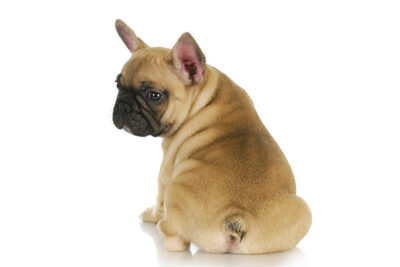Dogs are amazing creatures. They can do so much and love to do it all in the most adorable way possible. Dogs excrete moisture through their anal sacs, which evaporates when they’re hot. If you’ve ever wondered ‘why do dogs drag their butts,’ there are a few possible reasons you are about to read here. Enjoy!
Dogs may drag their butts because of anal sac issues, which cause them to have an itchy or irritated anus and are attempting to scratch or alleviate the discomfort. This behavior is known as “scooting.”
Anal sacs are sacs that contain a liquid, usually mucus. The sacs are located at the base of the rectum. When dogs drag their tails, they try to get rid of an anal sac issue.
This itchy or irritated anus can be caused by an anal gland impaction or infection, which can cause discomfort and the desire to drag the butt on the ground.
In some cases, the behavior may also signify a dietary issue or a behavioral problem. It is always best to consult a veterinarian if you notice your dog exhibiting this behavior, as they can help identify the cause and provide appropriate treatment.
Why do dogs drag their butts?
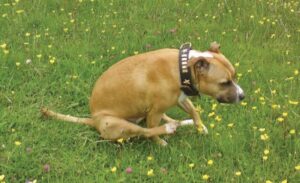
Dogs might drag their butts on the ground for a few different reasons.
One common reason is that they are trying to scratch or relieve an itch in their anal region.
Dogs have scent glands near their anus that can become irritated or inflamed, causing them to feel the need to scratch or rub the area to find relief. This can sometimes result in a dog dragging its butt on the ground or other surfaces.
Another possible reason for a dog dragging its butt on the ground is that they have diarrhea or other digestive issues. This can lead to irritation or discomfort in the anal region, and the dog may try to alleviate this discomfort by dragging its butt on the ground.
If your dog is dragging their butt on the ground, it is important to observe its behavior and try to determine the cause.
Suppose other symptoms, such as diarrhea or vomiting, accompany the behavior. In that case, it may be necessary to consult with a veterinarian to determine the underlying cause and receive appropriate treatment.
In some cases, simple measures such as cleaning the anal area or providing the dog with a soothing ointment or cream may alleviate the discomfort.
How do I get my dog to stop scooting?
There are a few steps you can take to help your dog stop scooting:
1. Clean your dog’s anus: If the scooting is due to an itchy or dirty anus, gently cleaning the area with a damp cloth or baby wipe may help alleviate the discomfort. Be sure to dry the area thoroughly to prevent further irritation.
2. Provide a healthy diet: A healthy diet can help prevent anal gland problems and other digestive issues that may cause scooting. Be sure to feed your dog a high-quality diet appropriate for their age, size, and activity level.
3. Try a commercial product: There are commercial products available that can help soothe an irritated anus and prevent scooting. These products can be found at your local pet store or online.
4. Address any behavioral issues: If the scooting behavior is due to a behavioral issue, such as separation anxiety or boredom, addressing the underlying cause may help stop the behavior.
This may involve providing more mental and physical stimulation, addressing separation anxiety with behavior modification techniques, or seeking the help of a professional dog trainer or behaviorist.
It is important to note that scooting can signify an underlying medical issue and should not be ignored. If the behavior persists or you cannot determine the cause, it is always best to consult with a veterinarian for further evaluation and treatment.
Does pumpkin help dog scooting?
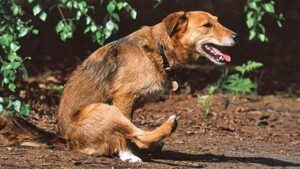
Pumpkins can be a helpful dietary addition for dogs experiencing scooting due to constipation or other digestive issues. Pumpkin is a good source of fiber, which can help regulate the digestive system and alleviate constipation.
However, it is important to use pumpkins in moderation, as too much fiber can cause digestive issues. It is always best to consult with a veterinarian before making any changes to your dog’s diet so that they can recommend the appropriate amount of pumpkin to add based on your dog’s size, age, and specific needs.
If your dog is experiencing scooting due to an anal gland issue or another medical condition, adding pumpkin to their diet may not resolve the problem.
In these cases, it is important to address the underlying cause of the scooting behavior and follow your veterinarian’s recommendations for treatment.
What are home remedies for dog scooting?
If your dog is always scooting around the house, you might wonder what to do about it. Here are some home remedies for dog scooting that may provide some relief:
1. Clean the area: Gently clean the anus and surrounding area with a warm, damp cloth to remove any dirt or debris causing irritation.
2. Apply a warm compress: A warm compress can help to soothe the area and reduce inflammation.
3. Add fiber to their diet: Increasing the fiber in your dog’s diet can help prevent constipation and relieve discomfort.
4. Use a non-toxic, anti-itch spray: Look for a spray containing natural ingredients, such as aloe vera or chamomile, to relieve itching.
5. Provide your dog with plenty of fresh water: Keeping your dog hydrated can help to prevent constipation and reduce the risk of anal gland problems.
Again, it is important to consult a veterinarian to diagnose and treat your dog’s scooting properly.
Why is my puppy dragging his bum on the floor after pooping?

It’s usual for a puppy to drag its bum on the floor after pooping. You’ve probably seen this behavior before, and it’s normal for puppies to do it.
When you see your puppy dragging its bum on the floor after pooping, that means that your pup is trying to drag away all of its waste. This is how they get rid of their stool and other wastes before they go outside to play or go potty again.
This happens because puppies have soft bottoms and don’t have enough muscle mass yet to hold up their weight while they poop. So when they’re finished pooping, they’ll try to clean themselves as best as possible.
This can also help ensure their poop is well-dispersed to prevent having too much of it in one area, so it doesn’t smell bad or cause any health problems later.
When should I worry about dog scooting?
Scooting, or dragging the hind end along the ground, can signify several issues in dogs. If your dog is occasionally scooting and appears otherwise healthy, it may not be cause for concern.
However, if your dog is frequently scooting or appears in discomfort, it is important to consult a veterinarian. Scooting can be a sign of underlying medical conditions that require treatment.
Some possible causes of scooting include anal gland problems, parasites, allergies, skin conditions, and constipation. A veterinarian can determine the cause of your dog’s scooting and recommend the appropriate treatment.
In addition, if your dog is scooting and experiencing any of the following symptoms, it is important to seek veterinary care as soon as possible:
1. Blood in the stool or urine
2. Loss of appetite or weight loss
3. Vomiting or diarrhea
4. Fever
5. Difficulty breathing or lethargy
It is important to address any medical issues as soon as possible to ensure the best possible outcome for your dog.
Does a dog scooting mean worms?

It is important to note that worms are just one potential cause of scooting in dogs. It is important to have your dog evaluated by a veterinarian to determine the cause and appropriate treatment.
In addition to scooting, other signs of worms in dogs can include weight loss, diarrhea, vomiting, and poor coat condition.
If you suspect your dog may have worms, it is important to have them checked by a veterinarian as soon as possible, as worms can cause serious health problems if left untreated.
How do you know if your dog’s glands are full?
There are several ways to determine if your dog’s anal glands are full and need to be expressed. One common sign is if your dog is constantly licking or biting at its rear end.
Other signs include scooting (dragging their hind end along the ground), lethargy, and bowel movements or behavior changes. You may also be able to feel or see a small, firm bump near your dog’s anus, which indicates that the glands are full.
If you suspect that your dog‘s glands are full, it is important to have them expressed by a veterinarian or a trained professional. If the glands are allowed to become too full or impacted, it can lead to discomfort, infection, and other serious health problems.
Why does my dog drag himself across the carpet?
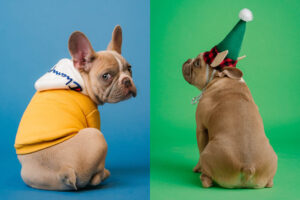
Scooting, or dragging the hind end along the ground or carpet, can signify several issues in dogs. Some possible causes of scooting include:
1. Anal gland problems: Dogs have two small glands near the anus that produce a strong-smelling secretion. If these glands become impacted or infected, a dog may scoot to try to relieve the discomfort.
2. Parasites: Scooting can also be a sign of parasites in the rectum or intestine, such as tapeworms or worms.
3. Allergies: Allergic reactions to food or environmental allergens can cause itching and discomfort in the anus, leading to scooting.
4. Skin conditions: Certain skin conditions, such as dermatitis or infections, can cause itching and discomfort in the anus, leading to scooting.
5. Constipation: If a dog is constipated, it may scoot in an attempt to relieve the discomfort caused by the hard stool.
It is best to consult a veterinarian to determine the cause of your dog’s scooting. They can examine your dog, assess any underlying medical conditions, and recommend the appropriate treatment.
My dog has been wormed but is still scooting
Your dog may still be scooting even after getting dewormed because they have anal gland issues. Dogs have small glands on either side of their anus that produce a smelly, oily substance.
These glands can become impacted or infected, causing discomfort and the desire to scoot. Scooting can also signify other issues, such as allergies, constipation, or a digestive issue.
It’s always best to consult with your veterinarian if your dog is exhibiting unusual behavior, such as scooting, as they can determine the underlying cause and provide the appropriate treatment.
Why is my dog still scooting after glands expressed?
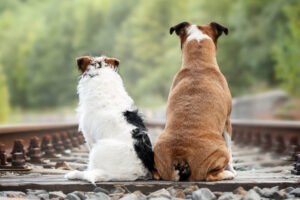
If your dog is still scooting after having its anal glands expressed, there may be an underlying issue causing the scooting behavior. Anal gland issues can be caused by various factors, such as diet, allergies, or an underlying health condition.
It’s important to consult with your veterinarian to determine the cause of your dog’s scooting behavior and get appropriate treatment.
In the meantime, you can try to alleviate any discomfort your dog may be experiencing by giving them a warm bath and gently cleaning their anus with a moist cloth or cotton ball. This can help to remove any excess discharge or debris that may be contributing to the scooting behavior.
How much does it cost to express dog glands?
The cost to express a dog’s anal glands will vary depending on a number of factors, such as where you live, the specific services provided, and your dog’s overall health.
The cost to express a dog’s anal glands can range from $20 to $50, although it may be higher or lower depending on the circumstances.
Some veterinarians may include the cost of expressing anal glands as part of a routine physical examination, while others may charge an additional fee for the service. It’s always best to check with your veterinarian to get an accurate estimate of the cost of expressing your dog’s anal glands.
How can I express my dog’s glands naturally?
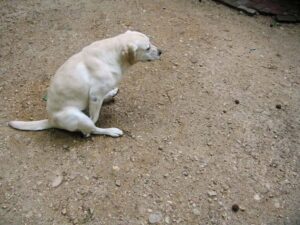
If your dog is suffering from swollen and hot glands, it might be time to give her some relief. To do this, you’ll need to first put a teaspoon of sea salt in a cup of warm water.
Then add eight drops of calendula tincture, and pour it onto a cloth. Hold the cloth against the inflamed area until it’s cool. Repeat this process every hour until the swelling goes down or until the glands open and drain on their own.
Conclusion
A dog’s butt is one of the fascinating parts of its body. It’s all about function, but it also looks like a little scrunched-up fluff.
There are several reasons why do dogs drag their butts on the ground, including anal gland issues, allergic reactions, rectal problems, and attention-seeking behavior.
If you notice your dog exhibiting this behavior, it is important to observe for other signs of discomfort or illness and consult a veterinarian if necessary.

